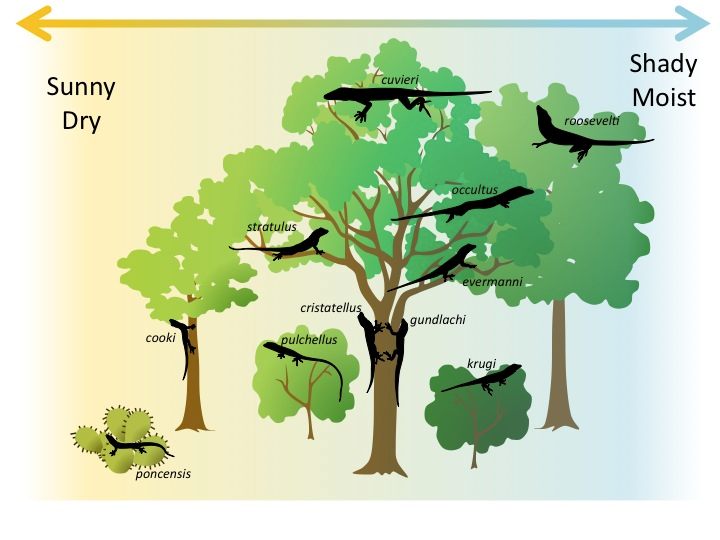Resource Partitioning Would Be Most Likely to Occur Between
Sympatric populations of a predator and its prey. Allopatric populations of the same animal species.
Allopatric populations of the same animal species.

. Course Title BIO 091. B allopatric populations of species with similar ecological niches. Resource partitioning would be most likely to occur between O Disjunct populations of a parasite and its host.
B sympatric populations of species with similar ecological niches. Sympatric populations of species with similar ecological niches. In any environment organisms compete for limited resources like food so organisms and different species have to find ways.
Sympatric populations of a predator and its prey. Resource partitioning would be most likely to occur between A sympatric populations of a predator and its prey. Resource partitioning would be most likely to occur between.
The access times are 5 nsec 15 nsec and 60 nsec respectively where the times for the level 2 cache and memory start counting at the moment it is known that they are needed e. Allopatric populations of species with similar ecological niches. Resource partitioning would be most likely to occur between Select one.
5 Resource partitioning would be most likely to occur between A sympatric populations of a predator and its prey. 7 Resource partitioning would be most likely to occur between A sympatric from BIO 091 at MARA University of Technology. O populations of species with similar ecological niches but.
O Co-occurring populations of two species eating similar food. D allopatric populations of the same animal species. A sympatric populations of a predator and its prey.
Populations of species with similar ecological niches living within the same area. Check each outcome that is likely to occur in the long-term if two species occupy the same niche. A sympatric populations of a predator and its prey.
Sympatric populations of species with similar ecological niches. O overlapping populations of a flowering plant and its specialized insect pollinator. Which explanations are consistent with the relatively low.
Allopatric populations of a flowering plant and its specialized insect pollinator. School MARA University of Technology. O A populations of a predator and its prey.
C sympatric populations of a predator and its prey. Sympatric populations of a flowering plant and its specialized insect pollinator d. Sympatric speciationis the evolution of a new species from a surviving ancestral species while both continue to inhabit the same geographic region.
Sympatric populations of a flowering plant and its specialized insect pollinator. B sympatric populations of species with similar ecological niches. 7 resource partitioning would be most likely to occur.
Resource partitioning would be most likely to occur between sympatric populations of species with similar ecological niches. Sympatric populations of a predator and its prey. Resource partitioning would be most likely to occur between.
Mitosis is the process that facilitates the equal partitioning of replicated chromosomes into. Same ecological niche will cause a greater competition between the species which are extant in it. D allopatric populations of the same animal species.
Allopatric populations of species with similar ecological niches. Allopatric populations of the same animal species. C sympatric populations of a flowering plant and its specialized insect pollinator.
Suppose that 60 of the memory references hit on the first level cache 35 hit on the second level and 5 miss. B sympatric populations of species with similar ecological niches. Sympatric populations of species with similar ecological niches.
O populations of species with similar ecological niches but on separate islands. Resource partitioning would be most likely to occur between _____. Is the way of division of resources by species with similar ecological niche to avoid competition in an ecological niche which help in reduce competition through which species with similar ecological niche can coexist.
1Sympatric populations of a predator and its prey 2Sympatric populations of species with similar ecological niches 3Sympatric populations of a flowering plant and its specialized insect pollinator 4Allopatric populations of the same animal species 5Allopatric populations of species with similar. Resource partitioning would be most likely to occur between _____. Sympatric populations of predator and its prey c.
Sympatric populations of species with similar ecological niches. Resource partitioning would be most likely to occur between A. B sympatric populations of species with similar ecological niches.
A stock split is most likely to occur when What happens to the nucleus of a cell before mitosis begins. G a level 2 cache. Acomputer has a two-level cache.
Resource partitioning would be most likely to occur between A sympatric Resource partitioning would be most likely to occur School University of Illinois Urbana Champaign. Resource partitioning would be most likely to occur between populations of species with similar ecological niches living within the same area. Sympatric populations of species with similar ecological niches b.
So resource partitioning most prominently happens between sympatric species with same ecological niche. C sympatric populations of a flowering plant and its specialized insect pollinator. Resource partitioning would be most likely to occur between _____.
Sympatric populations of a flowering plant and its specialized insect pollinator. Resource partitioning would be most likely to occur between populations of a predator and its prey. Each are equally likely O A population of a single species.
D allopatric populations of the same animal species. 22 Resource partitioning would be most likely to occur between A sympatric populations of species with similar ecological niches. C sympatric populations of a flowering plant and its specialized insect pollinator.
Resource partitioning would be most likely to occur between. O Co-occurring populations of a predator and its prey. Allopatric populations of the same animal species.
No comments for "Resource Partitioning Would Be Most Likely to Occur Between"
Post a Comment